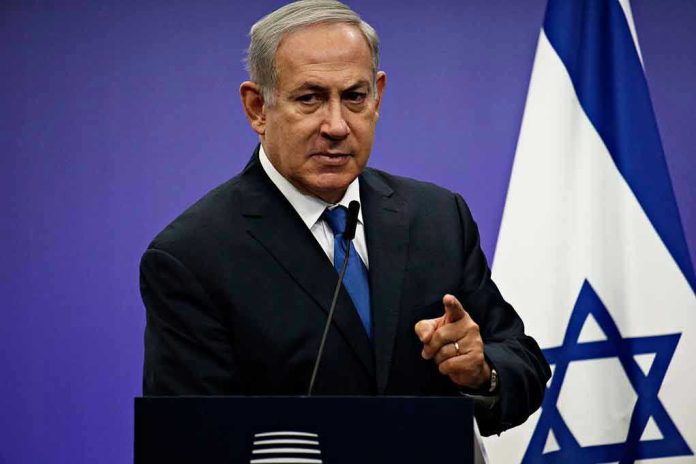
Trump and Netanyahu’s joint ultimatum to Hamas could reset the entire trajectory of the Gaza conflict, but the real suspense lies in whether Hamas will grasp the lifeline or trigger the region’s next shockwave.
Story Snapshot
- Trump and Netanyahu publicly demand Hamas accept a far-reaching peace plan or face intensified Israeli military action with full U.S. backing.
- The plan’s breadth surpasses previous proposals, offering international oversight and amnesty for non-combatant Hamas members without forcing Palestinians to leave Gaza.
- Arab and European governments rally behind the plan, while Hamas anxiously weighs its options in closed-door negotiations.
- The fate of Gaza’s population, Israeli hostages, and regional stability now hinges on Hamas’s response.
The White House Ultimatum: Peace or Peril for Gaza
The world watched as President Donald Trump and Israeli Prime Minister Benjamin Netanyahu stood side by side at the White House, unveiling a 20-point peace plan for Gaza. This wasn’t just another round of diplomatic theater; it was a high-stakes ultimatum. Hamas, battered but unbowed after two years of relentless conflict, was presented with terms that included a ceasefire, release of hostages, disarmament, and permanent exclusion from Gaza’s governance. Netanyahu’s warning was unequivocal: accept peace or Israel will “finish the job,” this time with explicit U.S. military and diplomatic support. The plan’s scope and the threat behind it marked a watershed moment, testing not only Hamas’s resolve but the entire region’s appetite for risk and reconciliation.
Arab capitals and European chancelleries responded with unusual speed and unity. Within twenty-four hours, joint statements of support poured in from Cairo, Riyadh, Ankara, Amman, Abu Dhabi, Jakarta, and even distant Islamabad. The Palestinian Authority voiced cautious approval and promised reforms. Qatar and Egypt, long-time mediators between Israel and Hamas, began shuttling the document to Hamas’s negotiators in Doha, where every clause was dissected behind closed doors. No formal response emerged, but the urgency was palpable. For once, the usual diplomatic inertia had given way to a race against time—each side knew that delay could mean disaster.
Why This Plan Is Different—and Why It Might Work
This peace proposal is not just a recycled ceasefire document. Its architecture is more robust, combining international oversight—something previous plans lacked—with a promise of amnesty for rank-and-file Hamas members who renounce violence. Crucially, it does not demand the displacement of Palestinians from Gaza. Instead, it envisions a phased transition overseen by a multinational stabilization force, tasked with rebuilding Gaza’s infrastructure, monitoring demilitarization, and facilitating humanitarian aid. Netanyahu’s endorsement signals Israel’s willingness to halt its campaign, but only if its three core objectives are met: the safe return of hostages, the dismantlement of Hamas’s military capabilities, and long-term security guarantees. The United States, leveraging its diplomatic muscle and military assets, has put its credibility on the line. For skeptics, this is the most comprehensive attempt yet to resolve the Gaza crisis, but for realists, the devil remains in the details.
The incentives for Hamas are clear but fraught with peril. Accept the plan, and they secure survival, potential international legitimacy for non-combatants, and a lifeline for Gaza’s battered population. Reject it, and they face the prospect of annihilation—not just from Israeli forces but from the region’s shifting alliances. The Arab states, increasingly wary of spillover conflict and humanitarian catastrophe, have made it clear that further escalation is unacceptable. Yet the psychological scars of war, distrust of Israel and the United States, and the fear of losing political relevance haunt Hamas’s leadership. Every hour without an answer deepens the suspense, leaving millions hostage to the outcome.
The Stakes for Gaza, Israel, and the Region
The immediate stakes are deadly serious. If Hamas accepts, hostages could be released, fighting may cease, and humanitarian corridors could open, allowing desperately needed aid to reach civilians. Reconstruction and investment would follow, perhaps offering Gaza its first real chance at stability in decades. If Hamas rejects the plan, Israel’s military will escalate operations with carte blanche from Washington. The risk of regional spillover rises, threatening Jordan, Lebanon, and even Egypt. For Gaza’s two million civilians, the difference between relief and ruin now depends on a handful of negotiators.
Expert views diverge sharply over the plan’s prospects. Some analysts praise the international oversight and phased approach, arguing that it finally addresses enforcement and accountability—two chronic failures of previous proposals. Others caution that Hamas’s willingness to disarm and surrender political control is far from guaranteed. Academic observers highlight the need for credible reconciliation mechanisms and warn that unless broader Palestinian buy-in is secured, any agreement risks collapse. On the ground, humanitarian groups brace for the worst, reminding policymakers that every delay costs innocent lives.
Sources:
Al-Monitor: Trump push Netanyahu Gaza peace plan White House
WTOP: Netanyahu and Trump are set to meet as pressure mounts to end war in Gaza
Africanews: Trump and Netanhayu agree to new US peace plan to end war in Gaza
Al-Monitor: Trump says Netanyahu has agreed deal end Gaza war






